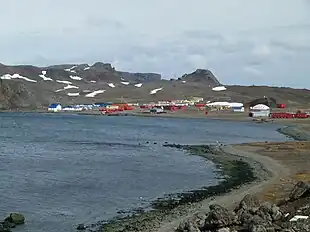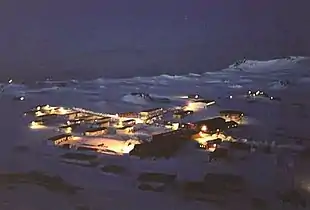Villa Las Estrellas | |
|---|---|
Village | |
 Villa Las Estrellas Villa Las Estrellas within Antarctica (politically part of Chile) | |
| Coordinates: 62°12′02″S 58°57′55″W / 62.200417°S 58.965278°W | |
| Country | |
| Region | |
| Province | Antártica Chilena |
| Commune | Antártica |
| Location | King George Island |
| Inauguration | 9 April 1984[1] |
| Government | |
| • Type | Municipality |
| • Magistrate | Responsibility of Puerto Williams Mayor and de facto Base Commander |
| • Municipal Council | Responsibility of Puerto Williams Council |
| Elevation | 10 m (30 ft) |
| Population (2017)[2] | |
| • Summer | 150 |
| • Winter | 80 |
| Time zone | UTC−3 (CLST) |
| UN/LOCODE | AQ ESC |
| Activities | Meteorology |



Villa Las Estrellas (Spanish pronunciation: [ˈbiʝa las esˈtɾeʝas]; Spanish for The Stars Village[3] or Hamlet of the Stars)[4] is a permanently inhabited outpost on King George Island within the Chilean Antarctic claim, the Chilean Antarctic Territory, and also within the Argentine and British Antarctic claims.
The Chilean government considers it to be in the commune of Antártica, in the province of Antártica Chilena, in the región of Magallanes and Chilean Antartica.
It is located on President Eduardo Frei Montalva Base, a research station. It is the larger one of only two civilian settlements on Antarctica (the other being Argentina's Esperanza Base).[4] It has a summer population of 150 and a winter population of 80.[5]
Government
The Office of the Civil Registry and Identification Service of Chile acts as official registry office with all the responsibilities inherent in this position.[6]
There is a Correos de Chile post office[7] staffed in the summer by a postal worker and by the command of the base in the winter. The office receives all its mail from Punta Arenas and is the mail depot and relay station for all mail addressed to any Chilean installation on Antarctica in addition to some other foreign facilities. From here it is delivered by hand, plane, or helicopter. The post office is also an attraction for tourists and philately enthusiasts that travel to the town to send postcards and letters with an Antarctic postmark.
The town is in the Piloto Pardo census district.
Community
The people of Villa Las Estrellas live in a community that has fourteen[8] 90 m² (970 sq. ft.) homes. Juan Pablo Camacho, the first Chilean born in the Antarctic region, was born at Villa Las Estrellas in November 1984.[4]
Education
F-50 "Villa Las Estrellas" School, a 1st–8th grade primary school staffed by two teachers that are responsible for providing education for the community's children, operated for 33 years until 2018, during which it educated over 300 children.[9][10][11] As of 2014, there were 6 students.[9] Library[7] No. 291 has a collection of books and magazines that are available upon request.
Healthcare
There is a Chilean Air Force Hospital staffed with one doctor and nurse[6] and equipped with X-ray, laboratory, surgery, anesthesia machine, sterilizer, and pharmacy services in addition to limited emergency and surgery capabilities. Two hospital beds are available in addition to a dental clinic.[12] Through a partnership with the Chilean Antarctic Institute and the University of Chile, in emergencies, medical images can be outsourced to specialized health centers in South America and Europe for diagnosis.
As of 2018 all residents, including children, are required to have their appendixes removed before coming to Villa Las Estrellas as a safety precaution, as healthcare services are limited.[13]
Business and recreation
A branch of Banco de Crédito e Inversiones operates throughout the year staffed by a sole banker.[10][4] Santa María Reina de la Paz (St. Mary Queen of Peace) is a Catholic chapel that attracts people from all over King George Island.
- Hostel: There is a small hostel named Estrella Polar[14] capable of holding a maximum occupancy of 20 guests.
- Souvenir shop: There is a small souvenir shop in town to sell to tourists and staff returning to the continent. It is run by the women of the town.
- The sports center[10] is the main community hub, in which a lot of activity takes place. Tennis practice, babyfútbol, basketball and volleyball. There are exercise machines, ping pong tables, dressing rooms and a sauna.[4] It is also used for cultural activities and scientific talks,[6] and has been used as a voting center.[10]
Communication
- Telephones: Telephones for the base and their airfield operate via satellite telephone and, for the inhabitants of the sector, there is a coin-operated pay phone and prepaid cards.
- Internet: There are computers at the school that have internet access.[7]
- Radio: Radio Soberanía (Sovereignty) broadcasts on the frequency of 90.5 MHz[15] during the day, providing music and information to all the bases in the area. Certain cultural and entertainment programs made by staff and their families are also disseminated.
- Television: The town has a fixed dish of 2.5 meters in diameter, which allows reception of live signals from the main television channels in the country, broadcasting from Santiago. Residents can also receive two broadcast stations. These are Televisión Nacional and Universidad Católica Television.
- Mobile phone: Since 2005, there is an antenna belonging to the Chilean company Entel PCS.[4]
Transportation
The nearest airport is the Teniente R. Marsh Airport, the only airport in Antarctica that has an IATA code. There is no regular scheduled public service to the airport, although Aerovías DAP has some charter flights from Punta Arenas.[16]
Climate
Villa Las Estrellas has a marine polar climate (Köppen ET) in which winter temperatures are much milder than in many well-populated wintry areas such as in Canada and Siberia. Summer temperatures however are extremely subdued; in effect narrowly above freezing, causing the climate to be hostile to human population. Sunshine levels are also extremely low. The yearly mean temperature of −2.3 °C (27.9 °F) is still gentle for Antarctica and milder than many places with vegetation.
| Month | Jan | Feb | Mar | Apr | May | Jun | Jul | Aug | Sep | Oct | Nov | Dec | Year |
|---|---|---|---|---|---|---|---|---|---|---|---|---|---|
| Record high °C (°F) | 13.0 (55.4) |
9.2 (48.6) |
8.3 (46.9) |
5.9 (42.6) |
4.6 (40.3) |
4.2 (39.6) |
5.0 (41.0) |
3.8 (38.8) |
4.4 (39.9) |
4.4 (39.9) |
6.0 (42.8) |
8.2 (46.8) |
13.0 (55.4) |
| Mean daily maximum °C (°F) | 2.7 (36.9) |
2.9 (37.2) |
2.2 (36.0) |
0.6 (33.1) |
−0.8 (30.6) |
−1.5 (29.3) |
−0.9 (30.4) |
−2.2 (28.0) |
−1.3 (29.7) |
−0.8 (30.6) |
0.0 (32.0) |
2.1 (35.8) |
0.3 (32.5) |
| Daily mean °C (°F) | 1.5 (34.7) |
1.6 (34.9) |
0.4 (32.7) |
−1.7 (28.9) |
−3.8 (25.2) |
−5.5 (22.1) |
−6.5 (20.3) |
−6.5 (20.3) |
−4.5 (23.9) |
−2.6 (27.3) |
−1.0 (30.2) |
0.6 (33.1) |
−2.3 (27.9) |
| Mean daily minimum °C (°F) | 0.3 (32.5) |
0.6 (33.1) |
−1.2 (29.8) |
−4.8 (23.4) |
−8.2 (17.2) |
−9.4 (15.1) |
−13.2 (8.2) |
−11.3 (11.7) |
−8.0 (17.6) |
−5.6 (21.9) |
−2.8 (27.0) |
−0.3 (31.5) |
−5.3 (22.5) |
| Record low °C (°F) | −5.1 (22.8) |
−5.8 (21.6) |
−9.9 (14.2) |
−16.8 (1.8) |
−23.6 (−10.5) |
−24.2 (−11.6) |
−28.5 (−19.3) |
−28.7 (−19.7) |
−23.0 (−9.4) |
−17.0 (1.4) |
−10.7 (12.7) |
−6.8 (19.8) |
−28.7 (−19.7) |
| Average precipitation mm (inches) | 53.8 (2.12) |
52.3 (2.06) |
52.5 (2.07) |
46.6 (1.83) |
31.0 (1.22) |
29.2 (1.15) |
32.2 (1.27) |
34.5 (1.36) |
42.0 (1.65) |
47.7 (1.88) |
41.0 (1.61) |
30.1 (1.19) |
492.9 (19.41) |
| Average relative humidity (%) | 91 | 89 | 89 | 89 | 88 | 90 | 89 | 88 | 89 | 90 | 89 | 81 | 89 |
| Mean monthly sunshine hours | 83.8 | 71.2 | 57.3 | 23.6 | 8.3 | 1.2 | 3.9 | 15.8 | 44.2 | 93.2 | 104.5 | 98.1 | 605.1 |
| Source: Dirección Meteorológica de Chile (temperature data:1970-2004, all other 1990-2000)[17] | |||||||||||||
See also
References
- ↑ "Villa Las Estrellas - Newsletter N°23" (PDF). Fundación Valle Hermoso. April 2021. p. 12. Retrieved 7 August 2023.
- 1 2 Antarctic Station Catalogue (PDF) (catalogue). Council of Managers of National Antarctic Programs. August 2017. p. 45. ISBN 978-0-473-40409-3. Archived (PDF) from the original on 22 October 2022. Retrieved 16 January 2023.
- ↑ Anthropologies and futures: researching emerging and uncertain worlds. London New York, NY: Bloomsbury Academic. 2017. pp. 157–158. ISBN 9781474264877. Retrieved 8 August 2023.
- 1 2 3 4 5 6 Romero, Simon (6 January 2016). "Antarctic Life: No Dogs, Few Vegetables and 'a Little Intense' in the Winter". The New York Times. Retrieved 7 August 2023.
- ↑ (in Spanish) Villa Las Estrellas
- 1 2 3 "Villa las Estrellas - Boletín Nº 23" (PDF). Fuerza Aérea de Chile. Departamento Comunicacional de la Fuerza Aérea de Chile. April 2018. Retrieved 7 August 2023.
- 1 2 3 Aradas, Anahí (23 April 2013). "Antártica: ¿cómo se vive en una de las zonas más remotas del mundo?" [Antarctica: what is it like to live in one of the world's most remote areas?]. BBC News Mundo (in Spanish). Retrieved 7 August 2023.
- ↑ Torres Bustillos, Gonzalo (2022). "Base Antártica Chilena Glaciar Unión "Zona 79-45"" (PDF) (in Spanish). Retrieved 7 August 2023.
{{cite journal}}: Cite journal requires|journal=(help) - 1 2 Cariceo Yutronic, Yanko (2014). "Certificación ambiental de la escuela más austral del mundo: escuela F50 Villa Las Estrellas, Antártica Chilena" [Environmental certification of the southernmost school in the world: F50 Villa Las Estrellas school, Chilean Antarctica.] (PDF) (in Spanish). Retrieved 7 August 2023.
{{cite journal}}: Cite journal requires|journal=(help) - 1 2 3 4 Bartlett, John; Smith, Sean (5 May 2023). "Island at the end of the world: Antarctic outpost faces uncertain times". The Guardian. Retrieved 7 August 2023.
- ↑ "Chilenos cierran escuela en Antárctica después de 33 años" [Chileans close school in Antarctica after 33 years]. MercoPress (in Spanish). 7 November 2018. Retrieved 7 August 2023.
- ↑ "Información básica para su viaje a la Antártida" (PDF). Sitio oficial de la República Oriental del Uruguay - GUB.UY. Instituto Antártico Uruguayo. p. 11. Retrieved 7 August 2023.
- ↑ Fisher, Richard (2018-08-10). "The icy village where you must remove your appendix". BBC. Retrieved 2018-09-21.
- ↑ Gorostegui Obanoz, José Javier; Waghorn Gallegos, Rodrigo (2012). Chile en la Antártica: nuevos desafíos y perspectivas (PDF). Santiago, Chile: Magíster en Política Exterior IDEA/ACADE ; USACH ; ADICA. p. 279. ISBN 9568416307. Retrieved 7 August 2023.
- ↑ "Radio History - Antarctic Radio Melts". Radio Heritage Foundation. Retrieved 7 August 2023.
- ↑ "Antarctica (United Kingdom v. Chile and Argentina)". International Court of Justice. Archived from the original on 2015-09-09. Retrieved 2010-01-26.
- ↑ Cerda, Jorge; Zamora, Monica (2007). "Climatología de la Península Antártica y de la Base Presidente Eduardo Frei Montalva" (PDF). Climatologica Antartica (in Spanish). Dirección Meteorológica de Chile. Archived from the original (PDF) on April 17, 2012. Retrieved May 10, 2013.


.svg.png.webp)